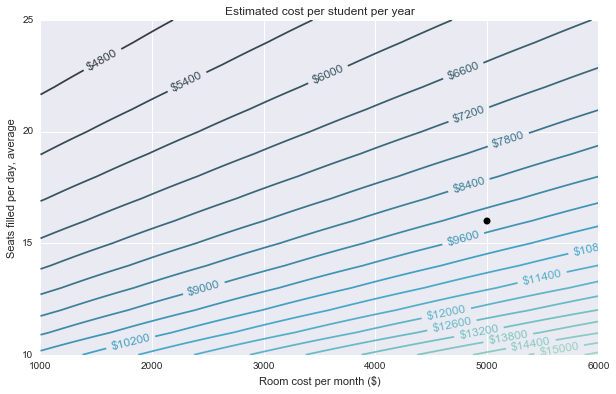I saw a post circulating Facebook that sardonically addressed some ‘real’ comments from Facebook about teacher salaries. That post, “Are you sick of highly-paid teachers?“, comes to the conclusion:
$1.42 per hour per student — a very inexpensive baby-sitter and they even EDUCATE your kids!
This doesn’t seem realistic at first glance, nor does it account for all the other factors that go into employing a person. Let’s be a bit more rigorous and understand the problem from the numbers side.
Problem Definition and Assumptions
The most raw components of running a business are (skip to the the TL;DR below for assumptions list):
- Physical Space
- Supplies
- Fully burdened salary (Benefits + taxes + take-home pay)
We’ll assume that internet, phone, cost of upkeep, etc. are all wrapped into the physical space. Supplies are things like paper, copiers, white board markers, etc. Finally, anyone who works has to pay payroll taxes (either through their self-employment, or their employer pays them). Benefits are also part of a fully burdened cost of labor since employers pay portions of retirement and health insurance.
Let’s create a hypothetical private teacher, Peda. Peda rents a room out of some office space to teach some number of children every day for 36 weeks. This office space is shared with other teachers (some might call this a ‘school’) so that way all the teachers rotate students and maintain a consistent average student load factor. In other words, ’30 students’ in this example means an average of 30 students are filling seats all day. This is to make the math work out for a parent who wants their child to learn more than one subject.
Based on some rough internet estimating (see [1] and [2]), I think it’s reasonable to estimate the cost of a classroom to be between $1,200 and $5,000 a month. That’s a wide range, but we’ll see some interesting results from the upper end of that. The lower end is just the physical space, while the upper end includes business services like internet, printing, and gourmet coffee.
The internet seems pretty unanimous that the cost of school supplies for a student (paid by the parents) is around $100 a year [3]. Let’s assume that Peda has to pay that much for various supplies per student as well. Let’s also assume that Peda is cutting costs by using all electronic resources and asks the parents to purchase a tablet of their choice for the student. That’ll run up to ~$700 for a big iPad, and let’s assume that an iPad lasts 2 years. This will also make up for the lack of computer lab.
The final piece is the desired fully burdened salary. To mirror the motivating article, let’s say that the take-home salary is $50K. A fully-burdened salary can be nearly double, but let’s assume that the government is nice to Peda and only $20K are lost to taxes and health insurance, making a fully-burdened target of $70K.
We’ll also assume that there are 10 classrooms in this hypothetical school supported by 2 admin professionals. The admin professionals will make a little less and be fully burdened at $50K.
Assumption Summary
- $1,200 to $5,000 per month in space rental for one classroom (must be for all year)
- $100 + $350 per year per student in supplies from the parents (regular + tablet)
- $100 per year per student in supplies from the teacher
- Fully-burdened salary target of $70,000 to estimate a $50K take-home salary
- 16 students per classroom (from [4]‘s data on public school student:teacher ratios)
- 10 classrooms
- 2 admins at $50K fully burdened
Results
Adding all that up, the ‘worst case’ cost per student per year is:
$9300.00/yr
To compare to the article, Peda’s students cost, assuming 7 hour days at school for 36 weeks, $7.38/hr. Varying the number of students and the cost of space shows the realm of feasible costs (with contours of constant cost and our worst case point shown):

Estimates vs. Reality
According to [5], the average cost per pupil in the United States is $10,000. Our rough estimate is pretty near that, but that’s on the upper end of room costs (I hope).So what’s missing? Well, everything that was missing in the article (and here)! Sports, lunches, administration, after school programs, buses, science equipment, libraries, computer labs, and a lot more.It’s almost as if the room cost is an ‘effective room cost’ that pays for everything else.
According to [4], private schools have a 12:1 student to teacher ratio. This will go a long way to increasing the per pupil cost at a constant salary. Private schools (according to that ratio) can only pay $55,000 fully burdened to teachers and $40,ooo fully burdened to our 2 admin staffers to maintain the lower ratio and have the same cost per student.
The Daily Kos article makes the same mistake as their motivating quote, which is to gloss over all the other things that go into the cost of education as the system is structured. The idea that the cost of education is just lumped into the salary of a teacher isn’t realistic, and it oversimplifies what could be driving the cost of education. Getting an initial estimate that is near the average cost per pupil has put some perspective on just how much goes into schools systems’ costs than a roof, equipment, and a teacher.
Hopefully you have a lot more questions about what drives costs in this area! I don’t have the answers, just some estimates. We also figured it out with math, so thank a teacher 🙂
References
[1] Lower bounds estimated assuming 600 sq/ft at $24/sqft/yr: https://42floors.com/us/ga/atlanta/1355-peachtree-st
[2] Alternative cost ~$5000: https://www.wework.com/locations/atlanta/buckhead
[3] $100 average supply cost: http://www.today.com/parents/school-supplies-average-cost-tops-100-1D80069506
[4] http://www.theatlantic.com/education/archive/2013/10/why-are-private-school-teachers-paid-less-than-public-school-teachers/280829/
[5] Cost of education per pupil: http://www.census.gov/newsroom/press-releases/2015/cb15-98.html